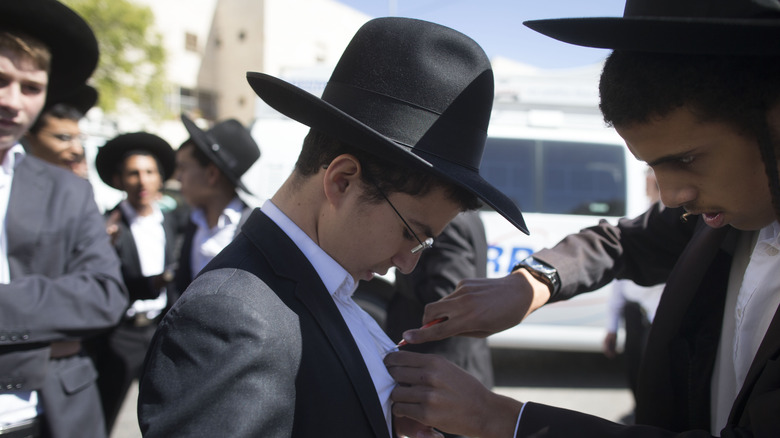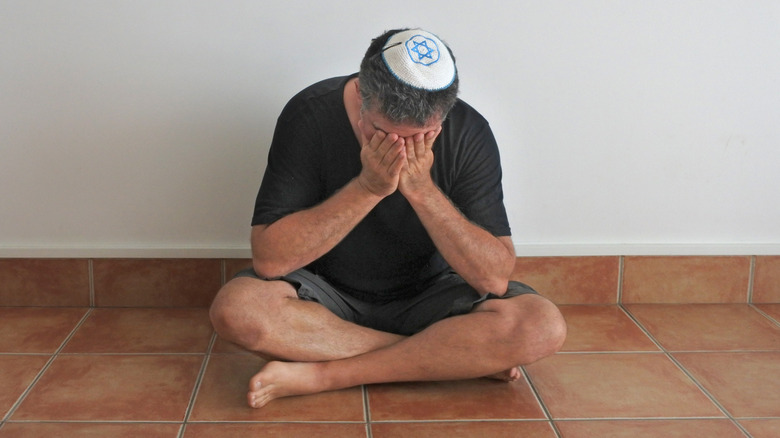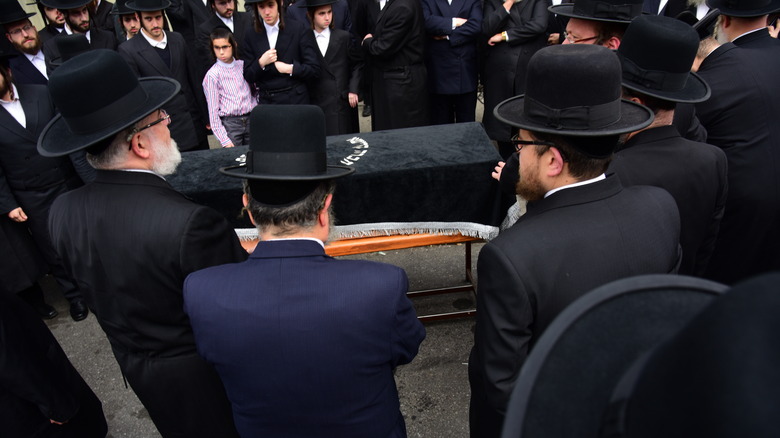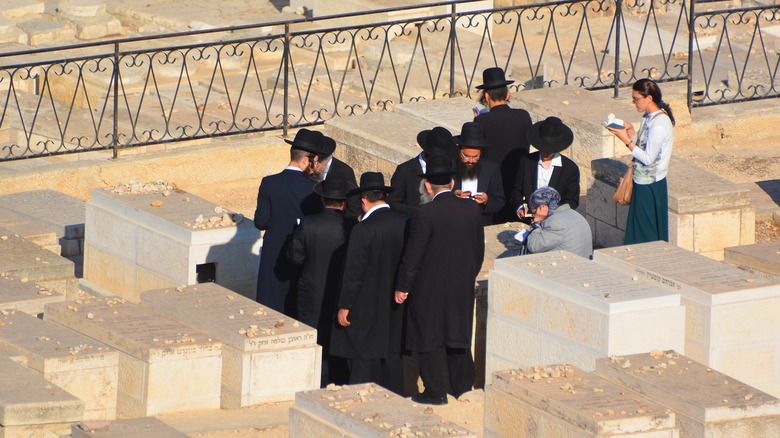The Real Reason Jewish People Tear Their Clothes After A Death
Grappling with the death of a loved one is devastating. Sometimes grief is so deep that many mourners experience insomnia, anxiety, loss of appetite, and even feelings of guilt, per HowStuffWorks. There is no timeline for how long grief lasts; a lot of times it may feel impossible for grievers to make peace with the finality of a loss and put their lives back together.
While death and grief are universal experiences, many people process it differently. Per Harvard Medical School, religious practices and spiritual beliefs often help people ease their sorrow. For example, the belief that a person will be reunited again with the deceased in an afterlife may help those in mourning feel connected with the departed. Further, the belief that their loved one is in a better place can comfort the mourners.
Many cultures and religions have traditions and rituals that help bereaved people cope and find solace. For example, Catholic tradition calls for a Vigil Service (or Wake), which usually takes place during the visitation period and allows the mourners to remember the deceased and ask the almighty for strength (via the United States Conference of Catholic Bishops). Similarly, the Jewish tradition of the Kriah helps mourners release their grief and suppressed anger around the time of a loved one's funeral (via My Jewish Learning).
Kriah -- The rending of clothes
Expressions of grief take many forms. In Hinduism, male mourners usually shave their heads as a symbol of grief. There was an ancient pagan custom of tearing the hair and skin to symbolize the loss of one's own flesh and blood. Since tearing hair and skin is forbidden by the Torah, Jewish mourners perform Kriah, which means tearing in Hebrew. Kriah is the tradition of rending clothes to express grief and anger after a death. Grieving loved ones cut their clothes over their heart. The tear represents a channel to release the deluge of emotions they are holding in (via Chabad.org).
The tradition aids the bereaved in acknowledging their loss, expressing anger, and confronting their grief openly. According to Chabad.org, the practice signifies that with the death of a loved one, only the physical bond is torn apart (the outer garment representing the body); the bonds between the souls of the deceased and the bereaved forged during their life remains. Furthermore, Kriah assists in giving the mourners mental comfort and releasing their emotional pain through a religiously-sanctioned act of destruction, explains Rabbi Maurice Lamm to Hadassah Magazine.
The Torah records many instances of rending garments after a death. For example, when Jacob, third of the patriarchs and grandson of Abraham, heard of his son Joseph's death, he tore his clothing. Likewise, David, the third king of the United Kingdom of Israel, tore his clothes upon learning about the death of King Saul (per Chabad.org).
A collective way to share love, loss, and grief
According to Chabad.org, only immediate relatives of the deceased –- father, mother, brother, sister, half-brother, half-sister, son, daughter, and spouse –- can perform Kriah. The practice is always performed standing and is usually done before the funeral service. Orthodox Jews generally tear their garments while Reform Jews use a ribbon that a rabbi tears and hands to the families to pin on their clothes, per the Jewish Federation of Greater MetroWest NJ.
Per Chabad.org, people who are grieving the death of a parent wear the Kriah ribbon or make a cut on the left side. All others expressing their pain and anger over the death of a relative wear the ribbon or make a cut on the right side. As Kriah is performed, the family then recites "Blessed is the true judge," which translates to, "Blessed are You, L‑rd our G‑d, King of the universe, the True Judge ... " (per Chabad.org).
Part of the Jewish traditions of mourning
Kriah is an integral part of the Jewish grieving process. According to Jewish law, friends, family, and relatives of the deceased typically observe "shiva," or a seven-day mourning period, after the burial to share in each other's pain and seek comfort. During shiva, the bereaved must wear their torn piece of clothing or ribbon, sit on low stools, avoid leather shoes, and not wash their clothes (via My Jewish Learning). Some mourners traditionally wear the Kriah ribbon during "shloshim," or a 30-day mourning period following the burial (except on Shabbat or Jewish holidays), to show their grief. Since shloshim is less intensive than shiva, the bereaved can go to work but must avoid dancing, parties, and festivities (via Kadish.org). If the deceased is a parent, grievers observe "avelut," or the 11-month mourning period following sheloshim (via Jewish Virtual Library).
Whether they mourn for seven days, 30 days, or for an entire year, the Kriah typically shows the world the bereaved are still in a state of mourning. The tearing of clothes or a ribbon can be a tangible expression of anger and sadness while also being a sensitive way to comfort mourners in their grief.



